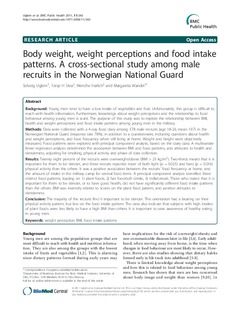| dc.contributor.author | Uglem, Solveig | |
| dc.contributor.author | Stea, Tonje H. | |
| dc.contributor.author | Frølich, Wenche | |
| dc.contributor.author | Wandel, Margareta | |
| dc.date.accessioned | 2011-07-13T12:19:29Z | |
| dc.date.available | 2011-07-13T12:19:29Z | |
| dc.date.issued | 2011 | |
| dc.identifier.citation | Uglem, S., Stea, T. H., Frolich, W. & Wandel, M. (2011). Body weight, weight perceptions and food intake patterns. A cross-sectional study among male recruits in the Norwegian National Guard. Bmc Public Health, 11: 343. | en_US |
| dc.identifier.issn | 1471-2458 | |
| dc.identifier.uri | http://hdl.handle.net/11250/138997 | |
| dc.description.abstract | Background: Young men tend to have a low intake of vegetables and fruit. Unfortunately, this group is difficult to reach with health information. Furthermore, knowledge about weight perceptions and the relationship to food behaviour among young men is scant. The purpose of this study was to explore the relationship between BMI, health and weight perceptions and food intake patterns among young men in the military.
Methods: Data were collected with a 4-day food diary among 578 male recruits (age 18-26, mean 19.7) in the Norwegian National Guard (response rate 78%), in addition to a questionnaire, including questions about health and weight perceptions, and food frequency when still living at home. Weight and height were objectively measured. Food patterns were explored with principal component analysis, based on the diary data. A multivariate linear regression analysis determined the association between BMI and food patterns, and attitudes to health and slenderness, adjusting for smoking, physical activity and phase of data collection.
Results: Twenty eight percent of the recruits were overweight/obese (BMI > 25 kg/m(2)). Two-thirds meant that it is important for them to be slender, and these recruits reported more of both light (p = 0.025) and hard (p = 0.016) physical activity than the others. It was a positive association between the recruits' food frequency at home, and the amount of intake in the military camp for several food items. A principal component analysis identified three distinct food patterns, loading on 1) plant foods, 2) fast food/soft drinks, 3) milk/cereals. Those who stated that it is important for them to be slender, or to have good health, did not have significantly different food intake patterns than the others. BMI was inversely related to scores on the plant food pattern, and positive attitudes to slenderness.
Conclusion: The majority of the recruits find it important to be slender. This orientation had a bearing on their physical activity pattern, but less on the food intake pattern. The data also indicate that subjects with high intakes of plant foods were less likely to have a high BMI than others. It is important to raise awareness of healthy eating in young men. | en_US |
| dc.language.iso | eng | en_US |
| dc.publisher | BioMed Central | en_US |
| dc.rights | Navngivelse 2.0 Internasjonal | |
| dc.rights.uri | https://creativecommons.org/licenses/by/2.0/deed.no | |
| dc.title | Body weight, weight perceptions and food intake patterns. A cross-sectional study among male recruits in the Norwegian National Guard | en_US |
| dc.type | Journal article | en_US |
| dc.type | Peer reviewed | |
| dc.rights.holder | © 2023 The Author(s) | |
| dc.subject.nsi | VDP::Medical disciplines: 700::Health sciences: 800::Nutrition: 811 | en_US |
| dc.source.pagenumber | 7 | en_US |
| dc.source.journal | BMC Public Health | |
| dc.identifier.doi | http://dx.doi.org/10.1186/1471-2458-11-343 | |
| dc.source.articlenumber | 343 | |

